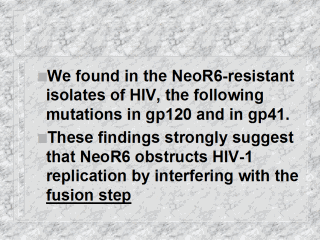 |
We have recently designed and synthesized
aminoglycoside–arginine conjugates (AACs) as potential anti-HIV-1 agents.
AACs exert a number of activities related to Tat antagonism. We here present
a new set of AACs, conjugates of neomycin B, paromomycin, and neamine with
different number of arginines (1–6), their (a) uptake by human T-cell lines,
(b) antiviral activities, (c) competition with monoclonal antibody (mAb)
12G5 binding to CXCR4, (d) competition with stromal cell-derived factor-1
(SDF-1) binding to CXCR4, and (e) competition with HIV-1 coat protein gp120
cell penetration. The appearance of mutations in HIV-1 gp120 gene in AACs
resistant HIV-1 isolates, supports that AACs inhibit HIV-1 infectivity via
interference of gp120–CXCR4 interaction. Our results point that the most
potent AACs is the hexa-arginine–neomycin conjugate, the other multi-arginine–aminoglycoside
conjugates are less active, and the mono-arginine conjugates display the
lowest activity. Our studies demonstrate that, in addition to the core, the
number of arginines attached to a specific aminoglycoside, are also
important in the design of potent anti-HIV agents. The AACs play an
important role, not only as HIV-1 RNA binders but also as inhibitors of
viral entry into human cells. |
